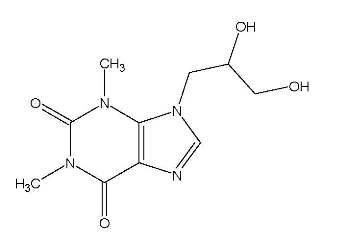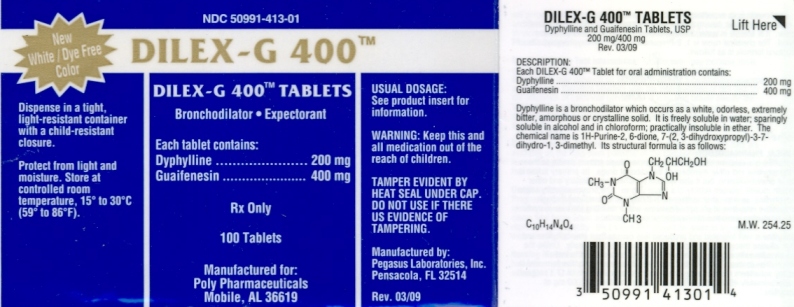DILEX-G 400
-
guaifenesin and
dyphylline tablet
Poly Pharmaceuticals
----------
Dilex - G 400 Label Information
DOSAGE AND ADMINISTRATION:DO NOT EXCEED RECOMMENDED DOSAGE. The usual adult dose is 1 tablet taken orally 3 or 4 times daily. In severe cases, dosage may be doubled or tripled if necessary. Maintenance dosage should be adjusted according to patient response.
Dyphylline is s bronchodilator which occurs as a white, odorless, extremely bitter, amorphous crystalline solid. It is freely soluble in water; sparingly soluble in alcohol and in chloroform; practically insoluble in ether. The chemical name is 1H-Purine-2, 6-dione, 7-(2, 3 dihydroxypropyl)-3-7dihydro-1, 3-dimethyl. It's chemical structure is as follows:

C10H14N4O4 M.W. 254.25
Guaifenesin is an expectorant which occurs as a white to slightly gray, crystalline powder, having a bitter taste. It may have a slight characteristic odor. It is soluble in water, alcohol, chloroform, glycerin, and propylene glycol. The chemical name is 1, 2-Propanediol, 3-(2-methoxyphenoxy). Its structural formula is as follows:

C10H14O4 M.W. 198.22
CLINICAL PHARMACOLOGY
Dyphylline is a xanthine derivative with pharmacological actions similar to those of theophylline and other members of this class of drug. Its primary action is that of bronchodilation, but it also exhibits peripheral vasodilatory and other smooth muscle relaxant activity to a lesser degree. The bronchodilatory action of dyphylline, as with other xanthenes, is thought to be mediated through competitive inhibition of phsphodiesterase with a resulting increase in cyclic AMP producing relaxation of bronchial smooth muscle.
Dyphylline is well tolerated and produced less nausea than aminophylline and other alkaline theophylline compounds when administered orally. Unlike the hydrolyzable salts of theophylline, dyphylline is not converted to free theophylline in vivo. It is absorbed rapidly in therapeutically active form and in healthy volunteers reaches a mean peak plasma concentration of 17.1 mcg/mL in approximately 45 minutes following a single oral dose of 1000 mg of dyphylline.
Dyphylline exerts is bronchodilatory effects and, unlike theophylline, is excreted unchanged by the kidneys without being metabolized by the liver. Because of this, Dyphylline pharmacokinetics and plasma levels are not influenced by various factors that affect liver function and hepatic enzyme activity, such as smoking, age, or concomitant use of drugs which affect liver function.
The elimination half-life of dyphylline is approximately two hours (1.8 - 2.1 hrs) and approximately 88% of a single oral dose can be recovered from the urine unchanged. The renal clearance would be correspondingly reduced in patients with impaired renal function. In anuric patients, the half life may be increased 3 to 4 times normal.
Dyphylline plasma levels are dose-related and generally predictable. The therapeutic range of plasma with which dyphylline can be expected to produce effective bronchodilation has not been determined.
Dyphylline plasma concentrations can be accurately determined using high pressure liquid chromatography (HPLC) or gas-liquid chromatography (GLC).
Guaifenesin is an expectorant which increased respiratory tract fluid secretions and helps to loosen phlegm and bronchial secretions. By reducing the viscosity of secretions, guaifenesin increased the efficiency of the mucociliary mechanism in removing accumulated secretions from the upper and lower airway. Guaifenesin is readily absorbed from the gastrointestinal tract and is rapidly metabolized and excreted in the urine. Guaifenesin has a plasma half-life of one hour. The major urinary metabolite is B - (2-methoxyphenoxy) lactic acid.
DILEX-G 400 is indicated as a bonchodilator-expectorant for treating bronchial asthma, or emphysema. DILEX-G 400 acts to dilate bronchioles and liquefy mucus, giving relief from dyspnea, non-productive cough and tracheobronchial irritation.
CONTRAINDICATIONS:
Hypersensitivity to any of the ingredients or related compounds.
WARNINGS:
DILEX-G 400 is not indicated in the management of status asthmaticus, which is a serious medical emergency.
Although the relationship between plasma levels of dyphylline and appearance of toxicity is unknown, excessive doses may be expected to be associated with in increased risk of adverse effects.
PRECAUTIONS:
General: use DILEX-G 400 with caution in patients with severe cardiac disease, hypertension, hyperthyroidism, acute myocardial injury or peptic ulcer.
Before prescribing medications to suppress or modify cough, it is important to ascertain that the underlying cause of cough does not increase the risk of clinical or physiological complications, and that appropriate therapy for the primary disease is instituted.
Drug Interactions: Synergism, between xanthine bronchodilators (e.g. theophylline), ephedrine and other sympathomimetic bronchodilators has been reported. This should be considered whenever these agents are prescribed concomitantly. Concurrent administration of dyphylline and probenecid, which competes for tubular secretion, has been shown to increase the plasma half- life of dyphylline (see Clinical Pharmacology).
Drug/Laboratory Test Interactions:Guaifenesin may increase renal clearance for urate and thereby lower serum uric acid levels. Guaifenesin may produce an increase in urinary 5-hydroxyindoleacetic acid and may therefore interfere with the interpretation of this test for the diagnosis of carcinoid syndrome. It may also falsely elevate the VMA test for catechols. Administration of this drug should be discontinued 48 hours prior to the collection of urine specimens for such tests.
Carcinogenesis, Mutagenesis, Impairment of Fertility:No data are available on the long-term potential of the components of this product for carcinogenis, mutagenesis, or impairment of fertility in animals or humans.
Usage in Pregnancy:
Pregnancy Category C: Animal reproduction studies have not been conducted with DILEX-G 400. It is also not known whether it can cause fetal harm when administered to a pregnant woman or can affect reproduction capacity. DILEX-G 400 should be given to a pregnant women only if needed.
Nursing Mothers:Dyphylline is present in human milk at approximately twice the maternal plasma concentration. Caution should be exercised when DILEX-G 400 is administered to a nursing woman.
Pediatric Use: Safety and effectiveness in pediatric patients below the age of six have not been established. Use caution when administering to pediatric patients six years of age or older.
ADVERSE REACTIONS:DILEX-G 400 may cause nausea, headache, cardiac palpitation and CNS stimulation. Postprandial administration may help avoid gastric discomfort.
The following adverse reactions have been reported with other xanthine bronchodilators and have been most often related to excessive drug plasma levels. They should be considered as potential adverse effects when dyphylline is administered.
Gastrointestinal: nausea, vomiting, epigastirc pain, hematemesis, diarrhea.
Central Nervous System: headache, irritability, restlessness, insomnia, hyperexcitability, agitation, muscle twitching, generalized clonic and tonic convulsions.
Cardiovascular: palpitation, tachycardia, extrasystoles, flushing, hypotension, circulatory failure, ventricular arrhythmias.
Respiratory: tachypnea.
Renal: albuminuria, gross and microscopic hematuria, dieresis.
Other: hyperglycemia, inappropriate ADH syndrome.
There have been no serious side effects reported with the use of guaifenesin.
OVERDOSAGE:
There have been no reports, in the literature, of overdosage with DILEX-G 400. However, the following information based on reports of theophylline overdosage are considered typical of the xanthine class of drugs and should be kept in mind.
Signs and Symptoms: Restlessness, anorexia, nausea, vomiting, diarrhea, insomnia, irritability, and headache. Marked overdosage with resulting severe toxicity has produced agitation, sever vomiting, dehydration, excessive thirst, tinnitus, cardiac arrhythmias, hyperthermia, diaphoresis, and generalized clonic and tonic convulsions. Cardiovascular collapse has also occurred with some fatalities. Seizures have occurred in some cases associated with very high theophylline plasma concentrations, without any premonitory symptoms of toxicity.
Treatment: There is no specific antidote for overdosage with drugs of the xanthine class. Symptomatic treatment and general supportive measures should be instituted with careful monitoring and maintenance of vital signs, fluids and electrolytes. The stomach should be emptied by inducing emasis if the the patient is conscience and responsive, or by gastric lavage, taking care to protect against aspiration especially in comatose or stuporous patients. Maintenance of ad adequate airway is essential in case oxygen or assisted respiration is needed. Sympathomimitic agents should be avoided but sedatives such as short-acting barbiturates may be useful.
Dyphylline is dialyzable and, although not recommended as a routing procedure in overdosage cases, hemodialysis may be of some benefit when severe intoxication is present or when the patient has not responded to general supportive symptomatic treatment.
Guaifenesin, when administered by stomach tube to test animals in doses up to 5 grams/kg, produced no signs of toxicity.
HOW SUPPLIED:
DILEX-G 400 TABLETS, each tablet of which contains Dyphylline 200 mg and Guaifenesin 400 mg are supplied as oblong white tablets, single scored and imprinted "Dilex G" on one side and "Poly 400" on the other side. DILEX-G 400 TABLETS are supplied in bottles of 100, NDC 50991-431-01
Storage: Dispense in tight containers with child-resistant closures.
Store at Controlled Room Temperature 15° to 30°C (59° to 86°F).

| DILEX-G 400
dyphylline and guaifenesin tablet |
||||||||||||||||||
|
||||||||||||||||||
|
||||||||||||||||||
|
||||||||||||||||||
|
||||||||||||||||||
|
||||||||||||||||||
| Marketing Information | |||
| Marketing Category | Application Number or Monograph Citation | Marketing Start Date | Marketing End Date |
| unapproved drug other | 09/08/2006 | 09/30/2011 | |
| Labeler - Poly Pharmaceuticals (198449894) |
| Registrant - Pegasus Laboratories Inc (007124357) |
| Establishment | |||
| Name | Address | ID/FEI | Operations |
| Pegasus Laboratories Inc | 007124357 | manufacture, analysis | |